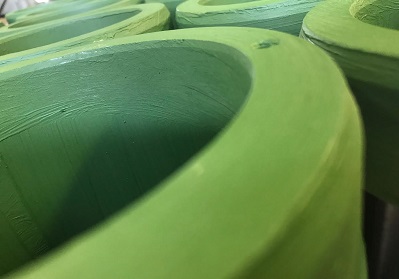Nitriding
The process
The nitriding process creates a nitrogen rich layer in the component. In practice, this generally takes the form of gas nitriding or plasma nitriding. Dominial has the possibility for gasnitriding, Gasnitriding is a diffusion process.
The longer the nitriding duration, the greater the nitriding hardness depth (NHD). The higher the temperature varies between 500 and 570 degrees, the further the nitrogen can penetrate in a given time. In general however, the internal hardness of the nitrided layer falls as the treatment temperature rises. Materials with nitride-forming elements (e.g. chromium, molybdenum, vanadium, aluminium) display a greater nitriding hardness, but the possible penetration depth of the nitrogen falls as the alloy content increases.
Dominial primarily uses gas nitriding. Here, nitrogen gas diffuses through a split ammonia gas atmosphere, generally at 500-570°C. Depending on the material, nitride hardness depths (NHD) of 0.1 – 1mm can be achieved by employing long treatment durations of 10-160 hours. The main objectives are improving component strength, wear resistance, sliding properties, and bending fatigue strength. Partial treatment can be performed using a paste insulation.
Benefits of this heat treatment
- Low distortion, less machining after nitriding
- High resistance to wear with adhesion
- Reduction in friction coefficients
- Saving in lubricants
- Formation of corrosion-resistant layers
- Thermal stability of nitriding layer to 400°C
- Partial nitriding possible
Customer information required for heat treatment
In addition to the material and the heat treatment prior to nitriding, the following information should be stated as quality standards in the production drawing:
- Material designation
- Surface hardness in HV (incl. test load)
- Nitriding hardness layer (NHD) in mm
- The drawing gives areas that should not be nitrided
Suitable materials
All common steel, cast and sinter materials can be treated by nitriding. Non-alloy, low alloy and medium alloy materials are suitable; high alloy materials (> 13% Cr) are mostly unsuitable due to their surface passivity, these materials can be plasmanitrided.
Possibilities for nitriding at Dominial
- Furnace dimension of Ø 1650 * 2200 mm.
- To depths of 0.1 – 1mm.
- Nitriding gears up to module 7.
- Can reach a hardness of 1200 Vickers.
- Dominial has advanced equipment to analyse and deliver NHT curves.
- Dominial has 4 Gas Retort Nitriding furnaces.
Contact form Nitriding
Would you like more information about nitriding? Please contact us!

